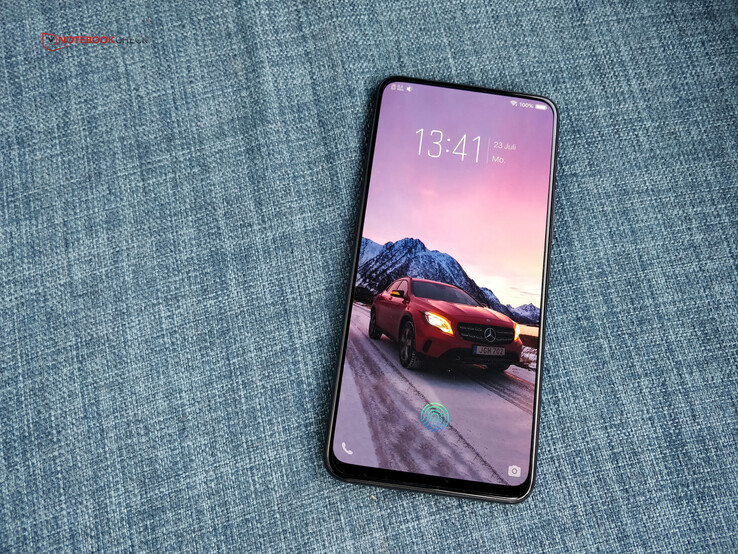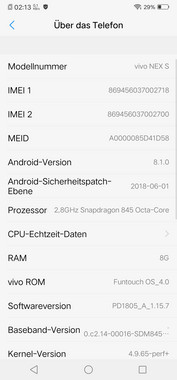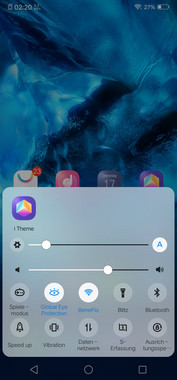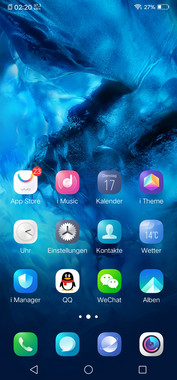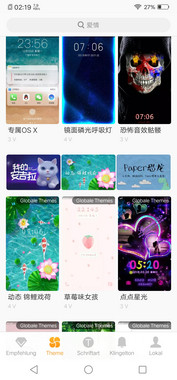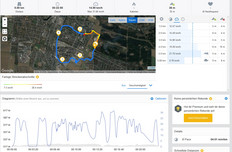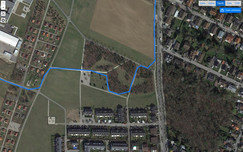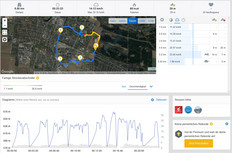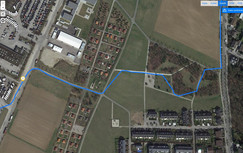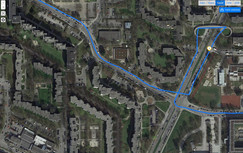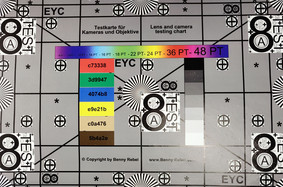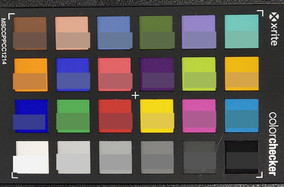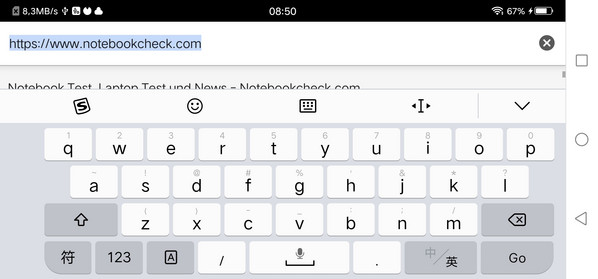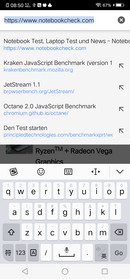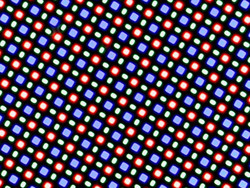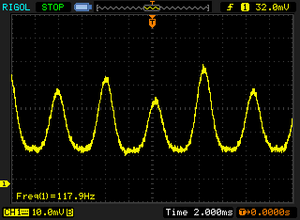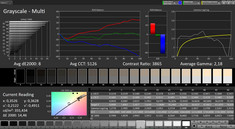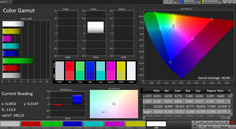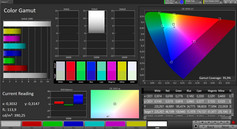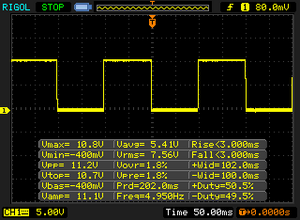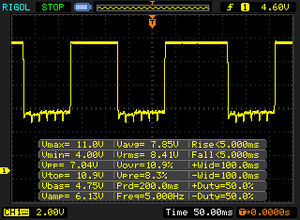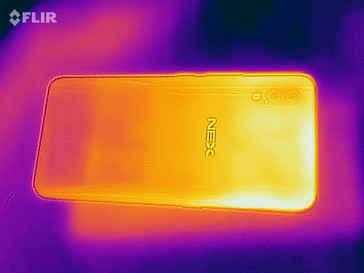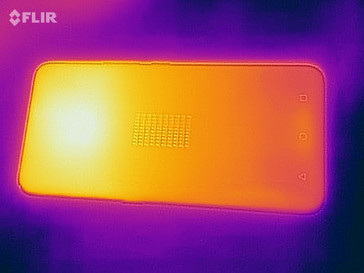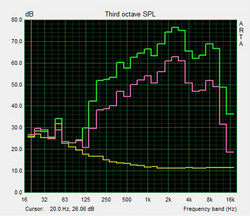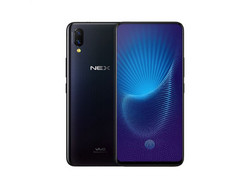Vivo Nex Ultimate Smartphone Review
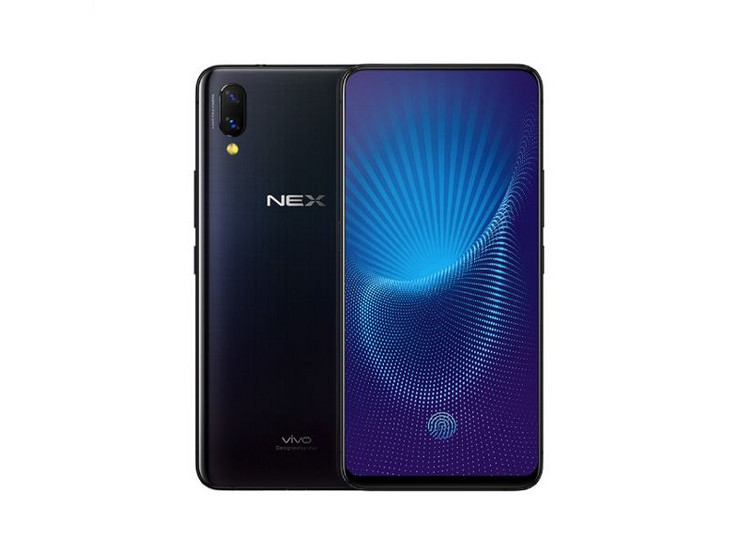
Everyone knows these full-bodied promises about smartphones with bezel-less displays: Lenovo for example, failed badly with its Z5. The compromise solution - a notch in the display, which houses the camera, sensors, and earphone - was not very well received by the customers. The Chinese manufacturer Vivo however, does not make only promises. In fact, they sent us a smartphone (via tradingshenzhen.com), whose display covers almost its entire front: no notch, very small bezels, and a front-facing camera extending from the top of the case if necessary. The Vivo Nex Ultimate appeals at first glance and is surprisingly well tailored to western users.
Vivo asks a high-end price of 699 Euros (~$820). However, the smartphone features plenty of the latest technology and up-to-date high-end components. With the Samsung Galaxy Note 8, the OnePlus 6, the LG G7 ThinQ, and the Xiaomi Mi Mix 2S, there is already a strong competition on the market.
Case - Stylish chassis
The Vivo Nex Ultimate is hard to get in western countries, you have to import it from China. Currently, you can order the device in red or black. In the future, there will be a blue option as well. Our review unit has a black case. The back looks very stylish with its dot pattern, breaking the light and shimmering in different colors. Apart from that, the back is made from glass, which is not very scratch resistant, and even feels like simple plastic. Our review unit has a protective foil on the back, which certainly protects the surface, but does not look very good: a mediocre quality impression for a smartphone in this price range.
The Vivo Nex Ultimate is relatively heavy and large. The dimensions are similar to those of the Samsung Galaxy Note 8. At nearly 8 mm (~0.3 in), the thickness is within the usual range. The extendable camera does not seem to require additional room. You can hardly warp the device, but you can push in the back significantly, which also reduces the quality impression.
Connectivity - The Vivo Nex Ultimate features plenty of storage
The Vivo Nex Ultimate device is equipped with 8 GB of RAM and 256 GB of storage. Vivo offers a version with 6 GB of RAM and 128 GB of storage as well. The storage cannot be extended by a microSD card.
The USB-C port is located at the bottom of the device. It transfers data with only USB 2.0 speed, but features USB OTG. The 3.5 mm headphone jack is located at the top.
Software - Independent Android version on the Vivo Nex Ultimate
The operating system of the Vivo Nex Ultimate is based on the current Android 8.1, which is almost not recognizable. In fact, the operation system is oriented towards another famous mobile operating system: Apple’s iOS. It has a different name, of course: Vivo calls it Funtouch OS. Operation, design, and even the settings menu feel very much like on iOS. This means that Android veterans have to adjust to it. The quick settings menu, for example, is located at the bottom of the screen, while you can still find the notifications at the top. The preinstalled keyboard app seems to be inspired by Apple as well. There is even a Siri, sort of: The Vivo smartphone features Jovi, a voice assistant software. However, it only speaks Chinese.
By the way, a common problem with imports from China is the software, which is often not properly translated. At best, there is an English version of the operating system. Some parts of the software are often still in Mandarin. But as a matter of fact, the Funtouch OS is different: It is available in every important language. The range of languages is similar to that of the stock Android. The translations are consistently on a high level. Of course, some apps are still only available in Mandarin, but these are always apps, that you do not necessarily need. The Google services are not preinstalled, as on every smartphone from China. However, if you connect with your Google account in the settings, the phone offers download and installation of Google services automatically. The process is snappy and works perfectly. After that, you can download every app you need from the Google Play Store.
Communication & GPS - Usable without any restriction, slow Wi-Fi
With 16 LTE bands, the Vivo Nex Ultimate is not a real world phone, but you can use it in Europe quite well. Nevertheless, you should check if the phone supports the bands you need, before traveling to more distant countries. The maximum LTE speed is slightly lower than the absolute top range, but with 1 GBit/s of download speed still very high. The reception in the German D2 network is quite good in urban areas. The display never shows less than half of the signal bars, even in buildings.
The smartphone supports every current Wi-Fi standard. The speed is rather fast, but not as fast as on other high-end devices, according to our test in conjunction with a Linksys ES8500 router. Close to the router, the Nex Ultimate has full signal strength, but the loading of websites is noticeably slow. Sometimes, you have to wait quite a while for images to be loaded. 10 meters (~33 ft) away from the router with three walls in between, there are still three quarters of the full signal strength available. Page loading times are similar to those close to the router.
| Networking | |
| iperf3 transmit AX12 | |
| Xiaomi Mi Mix 2S | |
| Samsung Galaxy Note 8 | |
| LG G7 ThinQ | |
| OnePlus 6 | |
| Vivo Nex Ultimate | |
| iperf3 receive AX12 | |
| LG G7 ThinQ | |
| Xiaomi Mi Mix 2S | |
| OnePlus 6 | |
| Vivo Nex Ultimate | |
| Samsung Galaxy Note 8 | |
In buildings, the GPS is only able to locate our position at the windows. Outdoors, the precision ranges within five meters (~16 ft), which is a good value. The compass is very reliable. The location services in Google Maps are snappy, if you are standing still.
To find out how the smartphone performs as a navigation device, we go on a bike trip with both the smartphone and a professional navigation device (Garmin Edge 520). The measured distances sometimes vary by 190 meters (~208 yd), which is a considerable difference for a total distance of 6 kilometers (~3.7 mi). Even the Garmin does not show the driven distance perfectly, but it still is significantly more accurate than the Vivo Nex Ultimate. Turns, for example, are not straightened as often. The side of the street we used is far better identified as well.
The Vivo smartphone is sufficient for occasional navigation tasks. If you need to navigate more often, you should consider buying a different smartphone.
Telephone features & call quality - Hidden earphone in the Vivo Nex Ultimate
Customers, who are used to Android’s standard phone app, have to adapt a little to the Vivo Nex Ultimate. The app only has a keypad with the recent calls shown above it. You can search for contacts using the number keys. There is also a separate key for the contacts tab.
To let the display cover the entire front of the phone, Vivo had to find a solution for the earphone. It usually sits above the display and needs an opening for letting the sound out. The manufacturer uses a piezoelectric speaker, located behind the display. This may sound futuristic, but it is working very well. Although you cannot see any earphone, the call partner is easy to understand and the sound is very clear. The maximum volume is satisfactory, but could be slightly louder. The microphone is good, no matter if our voice is loud or quiet. However, there is a slight overdrive at high sound pressure. The quality of the speaker is good as well. But here again, at high volume the the call partner sounds distorted and slightly rough. You have to speak loudly and directly into the microphone, so your call partner is able to understand you.
Cameras - Colorful images & an extendable front-facing camera
The 12 MP resolution of the rear-facing camera is not extraordinary for a high-end device. However, the camera is supported by a second 5 MP camera, used for blur calculation. The advantage of lower resolutions is larger pixels, which are able to absorb more light. This results in a very good low light performance: Images are very detailed and sharp. At normal light, images appear slightly oversaturated. Colors are almost unnatural. Of course, this is a matter of taste. The dynamics and the details are certainly appealing. The optical image stabilization helps preventing blur quite well.
You can record videos in 4K and 30 FPS. The quality is good: The exposure reacts quickly to changes in brightness, but the adjustment does not work continuously. Details and colors are reproduced well and the sound recording is loud and clear.
The front-facing camera is special: it extends from the top of the case if necessary, accompanied by a futuristic sound effect. This is not just a gimmick. It creates room for the almost bezel-less display and is also interesting for security reasons: No app can activate the front-facing camera without the user noticing it, because the camera has to extend first. We found out that GFXBench activates the front-facing camera every time we launched the app. The reason for that remains a mystery. With 8 MP, the front-facing camera offers a decent resolution. Images show clear details, but bright areas bloom quickly and the color reproduction is strong as well.
We take a picture of our test image in the laboratory under controlled lighting conditions. We are able to notice a significant blur in the image. However, the image is exposed appropriately and even larger areas of color are pictured correctly and without artifacts. Text on colored backgrounds does not cause any problems, however, the contrast between black text and dark blue background could be higher.
The color reproduction of our color chart is relatively bold and a little too bright.
Accessories and warranty - Plenty of accessories and Quick Charge
The Vivo Nex Ultimate comes with a quick charger, a USB-C cable, a SIM tool, a protective cover, and a headset. Of course, the charger has a Chinese plug, so you might need an adapter. Many Chinese dealers, however, enclose a suitable adapter. You can guess, how the charger and headset are designed: very similar to Apple’s accessories.
There is no warranty for the Vivo Nex Ultimate, because officially, the manufacturer offers products only for the Asian market. There are currently very few dealers in Europe who offer the smartphone, so you will not get a 2-year European warranty either. Please see our Guarantees, Return policies and Warranties FAQ for country-specific information.
Input devices and operation - Slow fingerprint reader
There are some special features on the Vivo Nex Ultimate in terms of the input devices. There is no visible fingerprint reader, which does not mean that it does not exist. The fingerprint reader is hidden behind the display. It activates, as soon as you approach or move the smartphone. This is shown by a symbol appearing on the screen. You will quickly notice, that the technology is working well but not perfectly: While you have to wait not even a second to unlock other devices with your finger, it takes the Vivo smartphone quite a moment to recognize your finger. The accuracy is also lower than on other devices. Furthermore, the fingerprint reader is sleeping as long as you do not see the symbol. It does not help to touch the spot, even if you know where it is. You first have to activate the phone.
Vivo developed an own keyboard app similar to Apple’s iOS keyboard, but it is not useful for European customers. First, there is only an English layout available. Second, it often switches to a Chinese input mode for password entry. However, the installation of other keyboard apps from the Play Store is hassle-free.
There is a distinct button on the left side of the case for activating the voice assistant, which is not useful for western users, because it only speaks Chinese. You can set up an action that happens, if you are pressing the volume down button for a longer time, while the phone is in standby mode: There are a single-hand mode, a split screen mode (only working with preinstalled apps), and some motion gestures available.
The Android navigation controls can be displayed on the screen, however, Vivo usually uses swipe gestures from the bottom of the display for menu control. It works quite intuitively, once you get used to it.
Display - Vivo smartphone with dark display
The large, almost bezel-less display is obviously the highlight of the Vivo Nex Ultimate. Its resolution is 2,316 x 1,080 pixels, which is technically a significantly widened Full HD resolution. Especially the strange aspect ratio of 2.14:1 and the uncommon screen size of 6.59 inches make the Vivo smartphone special. Other high-end devices offer more pixels, but the AMOLED display is sharp and 388 PPI is absolutely sufficient.
With 352 cd/m² however, the average brightness is too low. The LG G7 ThinQ offers almost three times the brightness and all the other competing devices are significantly brighter as well. With 95%, the distribution of brightness is quite consistent. Large colored areas are evenly illuminated.
| |||||||||||||||||||||||||
Brightness Distribution: 95 %
Center on Battery: 356 cd/m²
Contrast: ∞:1 (Black: 0 cd/m²)
ΔE ColorChecker Calman: 7.08 | ∀{0.5-29.43 Ø4.78}
ΔE Greyscale Calman: 4.7 | ∀{0.09-98 Ø5}
95.9% sRGB (Calman 2D)
Gamma: 2.096
CCT: 7297 K
| Vivo Nex Ultimate Super AMOLED, 2316x1080, 6.6" | Samsung Galaxy Note 8 Super AMOLED, 2960x1440, 6.3" | LG G7 ThinQ IPS, 3120x1440, 6.1" | Xiaomi Mi Mix 2S IPS, 2160x1080, 6" | OnePlus 6 Optic AMOLED, 2280x1080, 6.3" | |
|---|---|---|---|---|---|
| Screen | 45% | 63% | 32% | 37% | |
| Brightness middle (cd/m²) | 356 | 530 49% | 974 174% | 492 38% | 430 21% |
| Brightness (cd/m²) | 352 | 536 52% | 975 177% | 463 32% | 437 24% |
| Brightness Distribution (%) | 95 | 93 -2% | 96 1% | 90 -5% | 87 -8% |
| Black Level * (cd/m²) | 0.49 | 0.59 | |||
| Colorchecker dE 2000 * | 7.08 | 2.6 63% | 5.4 24% | 2.4 66% | 2.3 68% |
| Colorchecker dE 2000 max. * | 14.1 | 5.1 64% | 13.1 7% | 6.2 56% | 4.6 67% |
| Greyscale dE 2000 * | 4.7 | 2.7 43% | 5 -6% | 4.5 4% | 2.4 49% |
| Gamma | 2.096 105% | 2.04 108% | 2.31 95% | 2.25 98% | 2.28 96% |
| CCT | 7297 89% | 6206 105% | 7480 87% | 6395 102% | 6160 106% |
| Contrast (:1) | 1988 | 834 |
* ... smaller is better
Screen Flickering / PWM (Pulse-Width Modulation)
| Screen flickering / PWM detected | 117.9 Hz | ||
The display backlight flickers at 117.9 Hz (worst case, e.g., utilizing PWM) . The frequency of 117.9 Hz is very low, so the flickering may cause eyestrain and headaches after extended use. In comparison: 53 % of all tested devices do not use PWM to dim the display. If PWM was detected, an average of 8111 (minimum: 5 - maximum: 343500) Hz was measured. | |||
We noticed a significant screen flickering at a brightness level below 15%. The frequency of 117.9 Hz is relatively low, so sensitive users should test the screen first, before buying the smartphone.
It is not possible to change the white balance or other settings. There is only a blue light filter called Global Eye Protection. A test with the software CalMAN and the spectrophotometer reveals a considerable orange color cast. We notice a slight blue color cast with the default settings. With the blue light filter activated, the divergence from the reference color space is significantly higher. If set to normal, the overall divergences are slightly higher than on other smartphones in this price range. Although the measurements with CalMAN offer only an indication for coverage of the color gamut, sRGB seems to be covered pretty well. However, AdobeRGB is not reached.
Display Response Times
| ↔ Response Time Black to White | ||
|---|---|---|
| 6 ms ... rise ↗ and fall ↘ combined | ↗ 3 ms rise | |
| ↘ 3 ms fall | ||
| The screen shows very fast response rates in our tests and should be very well suited for fast-paced gaming. In comparison, all tested devices range from 0.1 (minimum) to 240 (maximum) ms. » 17 % of all devices are better. This means that the measured response time is better than the average of all tested devices (20.2 ms). | ||
| ↔ Response Time 50% Grey to 80% Grey | ||
| 10 ms ... rise ↗ and fall ↘ combined | ↗ 5 ms rise | |
| ↘ 5 ms fall | ||
| The screen shows good response rates in our tests, but may be too slow for competitive gamers. In comparison, all tested devices range from 0.165 (minimum) to 636 (maximum) ms. » 22 % of all devices are better. This means that the measured response time is better than the average of all tested devices (31.6 ms). | ||
The Vivo Nex Ultimate struggles during outdoor use, because the peak brightness is relatively low. The brightness sensor is not able to change that. At least, the sensor reacts quickly and reliably to changing light conditions.
The viewing angle stability of the screen is pretty good. The screen is always well readable and there is no brightness decrease when looking at the screen from the side.
Performance - High performance, slow web browsing
As a real high-end smartphone, the Vivo Nex Ultimate features the Snapdragon 845, which, as of now, is the fastest SoC from Qualcomm. This is why the device can keep up with current smartphones and even outperform last year’s Samsung Galaxy Note 8. In day-to-day use, you can notice the high performance during scrolling through menus and in fast reacting apps.
The SoC also contains the graphics unit Adreno 630, which is one of the fastest mobile graphics chips at the moment. Therefore, the Vivo smartphone does not have any problems to keep up with the graphics performance of other current high-end devices.
| AnTuTu v6 - Total Score (sort by value) | |
| Vivo Nex Ultimate | |
| Samsung Galaxy Note 8 | |
| LG G7 ThinQ | |
| Xiaomi Mi Mix 2S | |
| OnePlus 6 | |
| Average Qualcomm Snapdragon 845 (162183 - 242953, n=23) | |
| AnTuTu v7 - Total Score (sort by value) | |
| Vivo Nex Ultimate | |
| Samsung Galaxy Note 8 | |
| LG G7 ThinQ | |
| Xiaomi Mi Mix 2S | |
| OnePlus 6 | |
| Average Qualcomm Snapdragon 845 (246366 - 299878, n=27) | |
| PCMark for Android | |
| Work performance score (sort by value) | |
| Vivo Nex Ultimate | |
| Samsung Galaxy Note 8 | |
| LG G7 ThinQ | |
| Xiaomi Mi Mix 2S | |
| OnePlus 6 | |
| Average Qualcomm Snapdragon 845 (7998 - 13211, n=26) | |
| Work 2.0 performance score (sort by value) | |
| Vivo Nex Ultimate | |
| Samsung Galaxy Note 8 | |
| LG G7 ThinQ | |
| Xiaomi Mi Mix 2S | |
| OnePlus 6 | |
| Average Qualcomm Snapdragon 845 (7360 - 9868, n=27) | |
| GFXBench 3.1 | |
| on screen Manhattan ES 3.1 Onscreen (sort by value) | |
| Vivo Nex Ultimate | |
| Samsung Galaxy Note 8 | |
| LG G7 ThinQ | |
| Xiaomi Mi Mix 2S | |
| OnePlus 6 | |
| Average Qualcomm Snapdragon 845 (21 - 59, n=27) | |
| Average of class Smartphone (11 - 166, n=159, last 2 years) | |
| 1920x1080 Manhattan ES 3.1 Offscreen (sort by value) | |
| Vivo Nex Ultimate | |
| Samsung Galaxy Note 8 | |
| LG G7 ThinQ | |
| Xiaomi Mi Mix 2S | |
| OnePlus 6 | |
| Average Qualcomm Snapdragon 845 (32 - 61, n=28) | |
| Average of class Smartphone (8.4 - 413, n=158, last 2 years) | |
However, web browsing on the Vivo Nex Ultimate feels like someone has activated the handbrake. You have to wait much too long for loading images on websites and the overall loading times are also quite long. Benchmarks show only a low performance at rendering web contents. Complex HTML-5 sites such as Google’s Interland however, are rendered quite quickly, which shows that the Vivo device is acting strangely. It might be possible for Vivo to improve the web performance by delivering a patch.
| JetStream 1.1 - Total Score | |
| LG G7 ThinQ (Chrome 66) | |
| OnePlus 6 (Chrome 66) | |
| Average Qualcomm Snapdragon 845 (22.5 - 90.9, n=25) | |
| Xiaomi Mi Mix 2S (Chrome 66.0.3359.158) | |
| Samsung Galaxy Note 8 (Samsung Browser 6.0) | |
| Vivo Nex Ultimate (Chrome 67) | |
| Octane V2 - Total Score | |
| Average of class Smartphone (2228 - 121337, n=201, last 2 years) | |
| OnePlus 6 (Chrome 66) | |
| LG G7 ThinQ (Chrome 66) | |
| Average Qualcomm Snapdragon 845 (3991 - 18275, n=28) | |
| Xiaomi Mi Mix 2S (Chrome 66.0.3359.158) | |
| Samsung Galaxy Note 8 (Samsung Browser 6.0) | |
| Vivo Nex Ultimate (Chrome 67) | |
| Mozilla Kraken 1.1 - Total | |
| Vivo Nex Ultimate (Chrome 67) | |
| Average Qualcomm Snapdragon 845 (2154 - 11204, n=28) | |
| Xiaomi Mi Mix 2S (Chrome 66.0.3359.158) | |
| LG G7 ThinQ (Chrome 66) | |
| OnePlus 6 (Chrome 66) | |
| Samsung Galaxy Note 8 (Samsung Browser 6.0) | |
| Average of class Smartphone (257 - 28190, n=156, last 2 years) | |
| WebXPRT 2015 - Overall | |
| OnePlus 6 (Chrome 66) | |
| LG G7 ThinQ (Chrome 66) | |
| Average Qualcomm Snapdragon 845 (96 - 291, n=23) | |
| Xiaomi Mi Mix 2S (Chrome 66.0.3359.158) | |
| Samsung Galaxy Note 8 (Samsung Browser 6.0) | |
| Vivo Nex Ultimate (Chrome 67) | |
* ... smaller is better
The 256 GB UFS-2.1 storage is read out and written very fast, although it does not reach the extremely fast Xiaomi Mi Mix 2S. Nevertheless, apps are launched very quickly on the Vivo Nex Ultimate.
| Vivo Nex Ultimate | Samsung Galaxy Note 8 | LG G7 ThinQ | Xiaomi Mi Mix 2S | OnePlus 6 | Average 256 GB UFS 2.1 Flash | Average of class Smartphone | |
|---|---|---|---|---|---|---|---|
| AndroBench 3-5 | -8% | -8% | 122% | 0% | 167% | 621% | |
| Sequential Read 256KB (MB/s) | 687 | 797 16% | 695 1% | 756 10% | 726 6% | 829 ? 21% | 2226 ? 224% |
| Sequential Write 256KB (MB/s) | 228.4 | 205.9 -10% | 176.4 -23% | 208.1 -9% | 201.4 -12% | 376 ? 65% | 1848 ? 709% |
| Random Read 4KB (MB/s) | 126.7 | 122.5 -3% | 110.5 -13% | 135.1 7% | 137 8% | 168.8 ? 33% | 295 ? 133% |
| Random Write 4KB (MB/s) | 22.1 | 14.55 -34% | 23.26 5% | 128.4 481% | 21.8 -1% | 143.6 ? 550% | 335 ? 1416% |
| Sequential Read 256KB SDCard (MB/s) | 67.9 ? | 84.7 ? | 66.8 ? | ||||
| Sequential Write 256KB SDCard (MB/s) | 59.3 ? | 62.7 ? | 56.3 ? |
Games - The Vivo Nex Ultimate is suitable for games
We test the games “Arena of Valor” and “Asphalt 8: Airborne”. The frame rates are measured reliably by the app GameBench. We really wanted to test the demanding Battle-Royale-Game “PUBG Mobile” as well as “Shadow Fight 3”, but the installation process was interrupted repeatedly. The games that we are able to test run smoothly. “Arena of Valor” even runs with 60 FPS without any problems.
Apart from installation problems with some games, we can recommend the Vivo Nex Ultimate for gaming because the control via touchscreen or acceleration sensor works smoothly and without any delay.
| Arena of Valor | |||
| Settings | Value | ||
| min | 60 fps | ||
| high HD | 60 fps | ||
| Asphalt 8: Airborne | |||
| Settings | Value | ||
| high | 30 fps | ||
| very low | 29 fps | ||
Emissions - Throttled SoC and decent speaker
Temperature
During the GFXBench battery test, we were able to notice a throttling of the CPU and GPU after some time. After only a few runs of the benchmark, the frame rate dropped significantly. Eventually, only 85% of the performance was available.
The surface temperatures of the case, at the same time, are not dramatically high: 45.9 °C (~115 °F) is quite noticeable and a bit uncomfortable for high ambient temperatures, but not critical. At least, it is not the whole smartphone that becomes that warm. During longer idle times, the warming is hardly noticeable.
(-) The maximum temperature on the upper side is 45.9 °C / 115 F, compared to the average of 35.2 °C / 95 F, ranging from 21.9 to 247 °C for the class Smartphone.
(±) The bottom heats up to a maximum of 43.6 °C / 110 F, compared to the average of 34 °C / 93 F
(+) In idle usage, the average temperature for the upper side is 30.8 °C / 87 F, compared to the device average of 32.9 °C / 91 F.
Speaker
The mono speaker sits on the bottom edge of the device and can be quite loud: We measure up to 82.5 dB(A) using our test microphone and the software ARTA. At peak volume, the music playback is really loud, however, there is a very slight hum and high frequencies sound unpleasant. At three quarters of the peak volume, the sound becomes more balanced and is still quite audible in every spot of a medium sized room. The speaker can certainly keep up with other high-end smartphones, but does not break any records in terms of sound quality.
The included headset or other headsets can be connected via a 3.5 mm headphone jack. The sound reproduction is clean and you can activate a DSD mode with hardware decoding for the headphones output, and a Hi-Fi mode. The latter however, is only supported by some preinstalled apps.
All current standards up to Bluetooth 5.0 are usable and the sound reproduction over Bluetooth is clean as well.
Vivo Nex Ultimate audio analysis
(+) | speakers can play relatively loud (82.5 dB)
Bass 100 - 315 Hz
(-) | nearly no bass - on average 65.5% lower than median
(+) | bass is linear (0% delta to prev. frequency)
Mids 400 - 2000 Hz
(-) | nearly no mids - on average 65.5% lower than median
(+) | mids are linear (0% delta to prev. frequency)
Highs 2 - 16 kHz
(-) | nearly no highs - on average 65.5% lower than median
(+) | highs are linear (0% delta to prev. frequency)
Overall 100 - 16.000 Hz
(-) | overall sound is not linear (115% difference to median)
Compared to same class
» 87% of all tested devices in this class were better, 4% similar, 9% worse
» The best had a delta of 11%, average was 35%, worst was 134%
Compared to all devices tested
» 96% of all tested devices were better, 1% similar, 3% worse
» The best had a delta of 4%, average was 24%, worst was 134%
Samsung Galaxy Note 8 audio analysis
(+) | speakers can play relatively loud (86.9 dB)
Bass 100 - 315 Hz
(-) | nearly no bass - on average 27.1% lower than median
(±) | linearity of bass is average (11% delta to prev. frequency)
Mids 400 - 2000 Hz
(+) | balanced mids - only 4.4% away from median
(+) | mids are linear (5.3% delta to prev. frequency)
Highs 2 - 16 kHz
(±) | higher highs - on average 7.6% higher than median
(±) | linearity of highs is average (7.2% delta to prev. frequency)
Overall 100 - 16.000 Hz
(±) | linearity of overall sound is average (22.2% difference to median)
Compared to same class
» 46% of all tested devices in this class were better, 7% similar, 47% worse
» The best had a delta of 11%, average was 35%, worst was 134%
Compared to all devices tested
» 64% of all tested devices were better, 6% similar, 30% worse
» The best had a delta of 4%, average was 24%, worst was 134%
Battery life - Vivo’s smartphone features a very long battery life
Power consumption
The overall power consumption of the Vivo smartphone is low compared to other high-end devices. However, if switched off, there is still some energy consumption, which is not really good. As soon as you turn on the device, the energy consumption is pleasantly low. Even under high load, the power consumption is moderate, it reaches a maximum of 7.2 W.
| Off / Standby | |
| Idle | |
| Load |
|
Key:
min: | |
| Vivo Nex Ultimate 4000 mAh | Samsung Galaxy Note 8 3300 mAh | LG G7 ThinQ 3000 mAh | Xiaomi Mi Mix 2S 3400 mAh | OnePlus 6 3300 mAh | Average Qualcomm Snapdragon 845 | Average of class Smartphone | |
|---|---|---|---|---|---|---|---|
| Power Consumption | 8% | -24% | -26% | 7% | -19% | -26% | |
| Idle Minimum * (Watt) | 0.9 | 0.73 19% | 1.16 -29% | 0.75 17% | 0.6 33% | 0.862 ? 4% | 0.848 ? 6% |
| Idle Average * (Watt) | 1.5 | 1.44 4% | 1.98 -32% | 2.25 -50% | 1 33% | 1.728 ? -15% | 1.434 ? 4% |
| Idle Maximum * (Watt) | 1.7 | 1.53 10% | 2.07 -22% | 2.26 -33% | 1.6 6% | 2.07 ? -22% | 1.618 ? 5% |
| Load Average * (Watt) | 3.7 | 4.56 -23% | 4.51 -22% | 4.89 -32% | 4.3 -16% | 4.87 ? -32% | 7.01 ? -89% |
| Load Maximum * (Watt) | 7.2 | 5.09 29% | 8.3 -15% | 9.6 -33% | 8.6 -19% | 9.27 ? -29% | 11.3 ? -57% |
* ... smaller is better
Battery life
The very high battery capacity of 4,000 mAh is reflected in a battery life, which is one of the best in the high-end field: The smartphone endures over 17 hours in our Wi-Fi test. This is an excellent value. Thus, the Vivo Nex Ultimate easily survives a full day of work or school. Even if you do not charge the device for several days, you do not have to be afraid of running out of power when you are on the go.
The charger features the up-to-date QuickCharge 4+ standard, which is claimed to be more secure and even faster. In fact, the battery will be charged completely within one hour using the included 22.5-W charger.
| Vivo Nex Ultimate 4000 mAh | Samsung Galaxy Note 8 3300 mAh | LG G7 ThinQ 3000 mAh | Xiaomi Mi Mix 2S 3400 mAh | OnePlus 6 3300 mAh | |
|---|---|---|---|---|---|
| Battery runtime | -29% | -13% | -16% | -10% | |
| Reader / Idle (h) | 32.1 | 18.9 -41% | 27.7 -14% | 28 -13% | 30.1 -6% |
| H.264 (h) | 18.9 | 11 -42% | 15.1 -20% | 12 -37% | 13.2 -30% |
| WiFi v1.3 (h) | 17.1 | 7.9 -54% | 9.9 -42% | 11.9 -30% | 12.7 -26% |
| Load (h) | 3.4 | 4.1 21% | 4.3 26% | 4 18% | 4.1 21% |
Pros
Cons
Verdict - The smartphone for technology enthusiasts
The Vivo Nex Ultimate is a fascinating smartphone: First, it shows the technology of the coming years. Second, it shows that Chinese manufacturers can deliver a neatly translated operating system and adaptions to the western market. And there are so many things to gaze at: the extending front-facing camera, sliding out with a futuristic sound, the fingerprint reader and the speaker, both hidden behind the display, and the case, shimmering in every color of the rainbow. Additionally, the device offers high performance and good cameras.
With all fascination for the device, you should not ignore that you will not get a perfect smartphone for a price of 699 Euros (~$820): The case looks stylish, but is made from ordinary feeling material, the Wi-Fi is slower than on other high-end devices, and the GPS could work more precisely. The speaker is not the best one. The SoC offers high performance, however, it will be throttled considerably under load. The screen is somewhat dark and shows some flickering at low brightness levels. The fingerprint reader takes a while to detect a finger, if it is able to recognize it at all.
Bezel-less, packed with the latest technology and very stylish: This is the Vivo Nex Ultimate. It is not perfect, but a true recommendation for technology enthusiasts, and those who want to become one.
However, the battery life is simply amazing: After 17 hours of continuous Wi-Fi web browsing without any power outlet in reach, you may forgive the smartphone quite some things. Therefore, we can recommend the Vivo Nex Ultimate to anyone, who can live with some minor shortcomings, and is looking for a smartphone standing out from the crowd and having innovative features.
Vivo Nex Ultimate
- 07/23/2018 v6 (old)
Florian Wimmer




